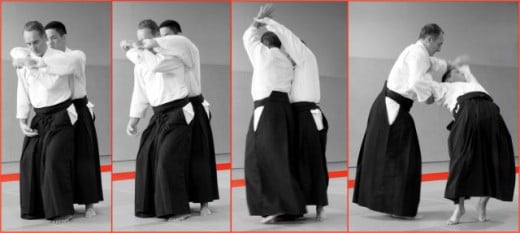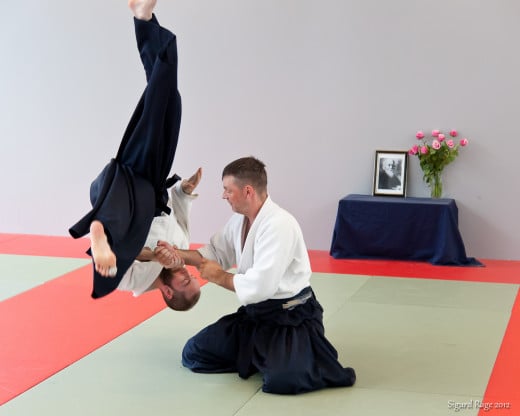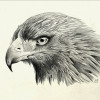- HubPages»
- Sports and Recreation»
- Individual Sports»
- Martial Arts
Kokyu Nage in Aikido - "20-year technique"

The "20-year technique" is usually the first throw taught to a beginner and is less specialized than many other projections you will meet later on. Kokyu Nage may be efficiently and smoothly applied to neutralize almost any type of basic attack, and can be developed from a great variety of introductory motions of evasion, extension, and centralization.
This technique can be applied to neutralize a variety of attacks; in each one, the main points to be observed (once you have completed your motion of evasion and centralization and are about to project Uke down onto the mat) will be the following: Uke must be spun around you in full dynamic extension; his body must be in full contact with yours; the total weight of your body will then shift around, slide down and rise up again in a powerful, wave-like motion, descending upon his unbalanced, upper frame; your balanced body, therefore, must be lowered for a moment (trunk erect, but knees well bent) and then uncoiled upward like a spring, following a spiralling pattern which will return down behind Uke; at the moment when you reverse your motion leading Uke around and down, his lower anatomy will still be in motion forward, while you are leading his upper trunk backward, where he has no support whatsoever.

Let's examine one of the situations where we can apply Kokyu Nage: same hand grab, or Katate Dori Gyaku Hanmi.
As uke grabs your left wrist with his right hand, you will turn and extend your hand (fingertips pointing upward) in the same direction as his motion, taking a step to his right side with your left foot and removing your hips from the path of his now-controlled extension. You will pivot on your left foot and take a circular step to your right side with your retreating right foot, Ieading uke around you in the tenkan motion as you turn with him. He will whirl around you and you will bend your knees deeply, leading him down along a sloping pattern which will extend him forward and cause him to lean against you. At this point you will describe a large circle with your leading left hand, returning toward uke from above as your body rises and your weight shifts from your right leg to your left, as illustrated. The lower part of his body meanwhile will still be spinning around you, almost on your right side. Both your arms-the right one extended over his head or across his neck, the left one across his chest-will guide his motion down to the mat. It is important that you maintain close contact with uke while his motion is being led up and back, because at that moment he will be extended into unbalance to his rear. In fact, it will be the dynamic use of your own body and its weight which will increase the momentum of his reversal.
Your arms will implement the spiralling rise of your body and its subsequent descent; they will not act alone. Your right hand may be used to feign a blow to the throat, chest, or stomach of the extended and therefore unprotected uke. If the motion of your body is really a total one, then its upward spiralling and powerful descent to his rear as well as the ample swing of both your arms should be more than sufficient to spin uke fully in the air and project him down to the mat. The function of your legs, therefore, will be extremely important in shifting your weight up and down in synchronization with his extension up and to his rear. The completion of the technique, however, will always find you in a condition of central balance.







